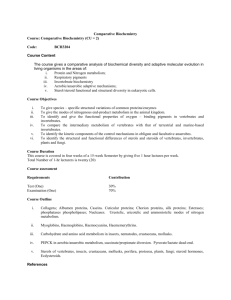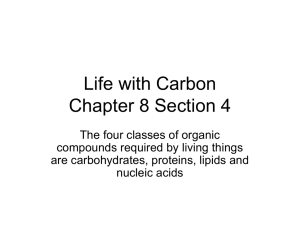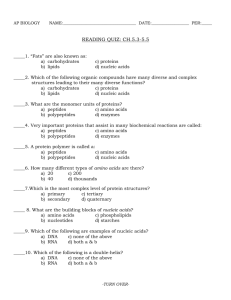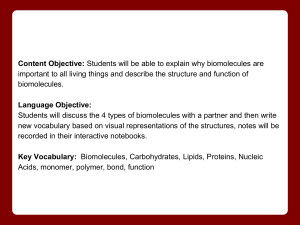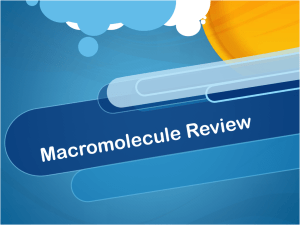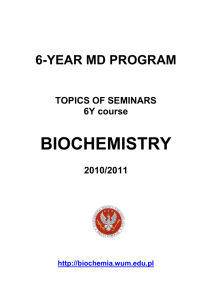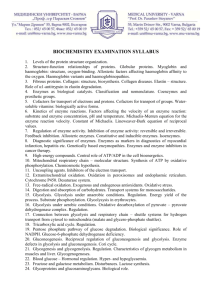Bio Chemistry
advertisement
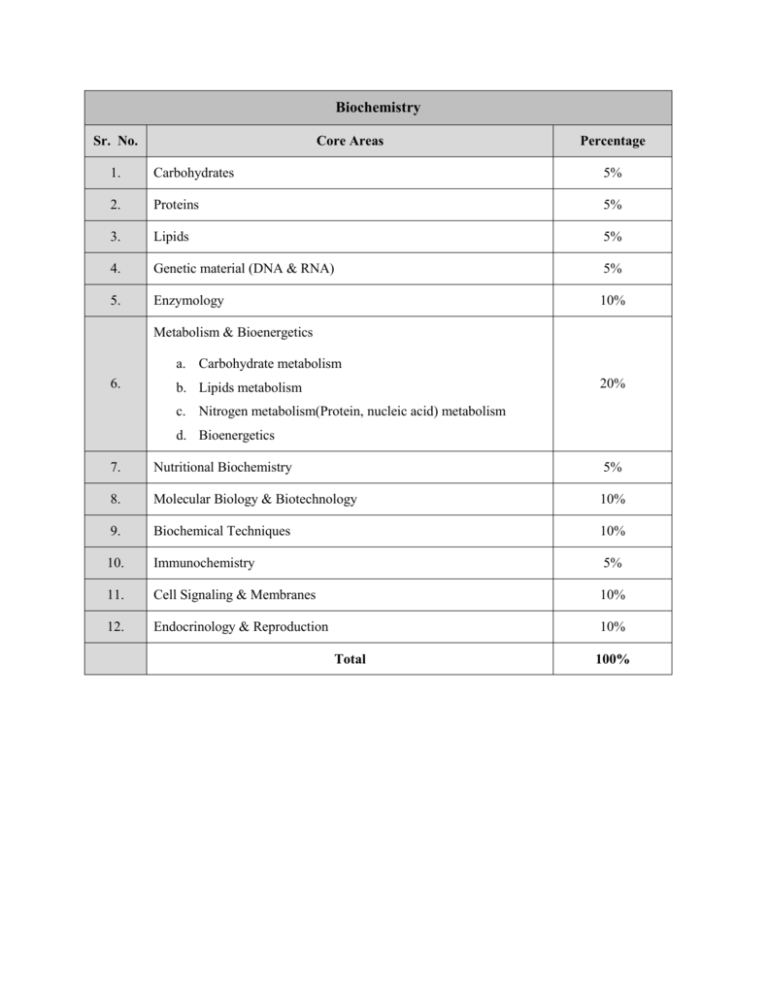
Biochemistry Sr. No. Core Areas Percentage 1. Carbohydrates 5% 2. Proteins 5% 3. Lipids 5% 4. Genetic material (DNA & RNA) 5% 5. Enzymology 10% Metabolism & Bioenergetics a. Carbohydrate metabolism 6. 20% b. Lipids metabolism c. Nitrogen metabolism(Protein, nucleic acid) metabolism d. Bioenergetics 7. Nutritional Biochemistry 5% 8. Molecular Biology & Biotechnology 10% 9. Biochemical Techniques 10% 10. Immunochemistry 5% 11. Cell Signaling & Membranes 10% 12. Endocrinology & Reproduction 10% Total 100% Biochemistry (Detailed) Sr. No. Core Areas Percentage CARBOHYDRATES 1.1. Classification 1.1.1. Monosaccharides 1.1.2. Oilgosaccharides 1.1.2.1 Disaccharides 1.1.2.2 Others 1.1.3. Polysaccharides 1. 1.1.3.1 Homopolysacharrides 1.1.3.2 Heteropolysacharrides 1.2. Structure 1.2.1. Anomers 1.2.2. Epimers 1.2.3. Enantiomers 1.2.4. Reducing & Non Reducing Sugars 1.2.5. Derived Carbohydrates 1.2.6. D & L and Optical Isomers 1.2.7. Ring Structure (Pyran & Furan) 5% PROTEINS: 2.1. Classification & Biological Role 2.1.1. Based on Solubility 2.1.2. Based on Shape 2.1.3.Based on Functions 2.1.3.1 Immunoglobulin 2.1.3.2 Regulatory 2.1.3.3 Contractile 2.1.3.4 Nutrition 2.1.3.5 Plasma Proteins 2.1.4.Based on 3 D 2. 2.2. Structure 5% 2.2.1.Levels of Organization 2.2.1.1 Primary 2.2.1.2 Secondary 2.2.1.3 Tertiary 2.2.1.4 Quaternary 2.3. Amino Acids 2.3.1. Classification based on 2.3.1.1 Nutrition 2.3.1.2 R Group 2.3.1.3 Biochemical importance (Glycogenic, Ketogenic) 2.3.2.Properties LIPIDS: 3.1 Classification & Biological Role 3.1.1 Primary 3. 3.1.2 Secondary 3.1.3 Derived 3.2. Structure – Fatty Acids 3.2.1 Essential – Non Essential 3.2.2 Saturated – Unsaturated 5% 3.3. Properties of Fatty Acids 3.3.1. Rancidity 3.3.2. Peroxidation 3.3.3. ROS (Reactive Oxygen Species) Chemistry of Nucleic acids (DNA & RNA): 4.1. Nitrogenous Bases 4. 4.2. Nucleosides 5% 4.3. Nucleotides 4.4. Nucleic Acids 4.5. Nucleoprotein complexes ENZYMOLOGY: 5.1. Normenclature, Units of enzyme activity, Coenzymes, Cofactors 5.2. Classification 5.3. Factor affecting enzyme activity 5.4. Regulatory Enzymes 5.4.1 Allosteric Activity 5. 5.4.2 Covalent Modification 5.4.3 Isoenzymes 5.4.4 Inhibition of Enzymes 5.5. RNA as an Enzyme 5.6. Clinical and industrial importance of Enzymes 5.7. Kinetics of Enzymes 5.7.1 Michaelis Menton Equation 5.7.2 Linweaver Burk Equation 5.8. Immobilization of Enzymes 10% METABOLISM & BIOENERGETICS: 6.1. Overview of Metabolism 6.2. Digestion, Absorption, Transport & Incorporation of: 6.2.1. Carbohydrates 6.2.2. Proteins 6.2.3. Lipids 6.2.4. Nucleoproteins 6.3. Metabolic pathways of carbohydrates & their regulation 6.3.1. Glycolysis 6.3.2. TCA 6.3.3. Gluconeogenesis 6.3.4. HMP shunt 6.3.5. Glycogenesis &Glycogenolysis 6.3.6. Advanced Glycation end Products (AGES) 6.3.7. Glycogen Storage Diseases 6. 6.3.8. Photosynthesis a. chlorophylls b. light harvesting c. light and dark reactions d. C3, C4 and CAM metabolism e. photorespiration f. Storage materials and their synthesis g. Nitrogen fixation 6.4. Metabolic Pathways of Lipids & their regulation 6.4.1. Synthesis of Fatty Acids 6.4.2. Oxidation of Fatty Acids 6.4.3. Phospholipids 6.4.4. Cholesterol Synthesis (Steroids & prostagladins) 6.4.5. Lipid storage and associated disorders 6.5. Metabolic Pathways of Proteins & Amino Acids 6.5.1. Nitrogen balance (urea cycle) 6.5.2. Detoxification of Ammonia in Birds Reptiles & Mammals 6.5.3. Metabolism of specific amino acids 20% 6.5.4. Inborn errors of Metabolism 6.5.5. Synthesis and degradation of Hemoglobin 6.5.6. Functions of Plasma Proteins 6.6. Nucleic Acids 6.6.1. Biosynthesis and degradation of purines &Pyramidines 6.6.2. Syntheisis of Nucleosides, nucleotides and nucleic acids 6.6.3. Disorders of Nucleoproteins 6.7. Bioenergetics 6.7.1. Oxidative Phosphorylation including Electron Transport Chain (ATPs calculations) 6.7.2. Photophosphorylation 6.7.3. Inhibitors ( Uncouplers) 6.8. Role of Vitamins & Minerals in Metabolism NUTRITIONAL BIOCHEMISTRY: 7.1. Food in Health and Disease 7.2. Balanced diet 7.3. Diet for 7.3.1. New Born (0-6 Months) 7.3.2. Infants (7 – 1 Year) 7.3.3. Children (1.1 – 12 years) 7.3.4. Teenagers (13-19 Years) 7. 7.3.5. Adults (20-45 years) 7.3.6. Old Age (46-70 Years) 7.4. Diet for Pregnant & Lactating Women 7.5. Diet for Athletes 7.6. Diet recommended for hypertensive, Cardiac & Renal Patients 7.7. Diet for obese & Patients with malnutrition (Marasmus, Kawashiorkor) 7.8. Diet for Diabetic Patients 7.9. Diet for Diarrohea Patients 7.9. BMR, PM, Caloric Value 5% 7.10. Composition & Caloric value in commercially available commodities MOLECULAR BIOLOGY & BIOTECHNOLOGY: 8.1. Genes, Chromosomes, Central Dogma 8.2. Cell Cycle 8.3. Mandelian laws of inheritance (Pedegree) 8.3.1. Autosomal Inheritance 8.3.2. Mitochondrial Inheritance 8.3.3. X-linked Diseases 8.3.4. Y-Linked Diseases 8.4. Replication & proof reading 8.5. Trancription – post transcriptional modifications 8. 8.6. Translation 10% 8.7. Post translational modifications 8.8. Human genome project & Mutations 8.9. Bioinformatics (Applications) 8.10. Genetic Engineering 8.10.1 Plasmid, vector, Translocation 8.10.2 Cloning 8.10.3 Recombinant DNA Technology 8.10.4. Nucleic Acid Sequencing 8.11. Proteomics Biosynthesis and sequencing of proteins 8.12. Metabolomics BIOCHEMICAL TECHNIQUES: 9.1. Solution & buffer system 9. Principles & applications of the following in Bio chemistry: 9.2. NMR 9.3 Amino Acid Analyzer 9.4. Chromatography 9.5. PCR & Electrophresis 10% 9.6. Western Blotting 9.7. Southern Blotting 9.8. Eastern Blotting 9.9. Northern Blotting 9.10. Fluorescence techniques 9.11. Use of labeled materials in Biochemistry 9.12. Mass Spectroscopy 9.13. ELISA 9.14. Microscopy 9.15. Spectrophotometry 9.16. Atomic Absorption spectrometry 9.17. Flame photometry 9.18. Hematological analyzer 9.19. Microbes based techniques 9.20. Nanotechnology IMMUNOCHEMISTRY: 10.1. Innate & Acquired immunity 10.2. Cell mediated & Humoral Immunity 10. 10.3. Antigens & Antibodies 10.4. Monoclonal & Polyclonal Antibodies 10% 10.5. In situ hybridization 10.6. HLA types & grafting 10.7. Interleukins, Cytokines, Interferons 10.8. Major Histocompatibility Complex (MHC) CELL SIGNALING & MEMBRANES: 11.1. Composition & Chemistry of membranes of the Cells & Organelles 11. 11.2. Receptors & transport channels 11.3. Second messenger system 11.4. Ca, IP3 mechanism 11.5. Role of the G Proteins 11.6. Protein Kinases/Tyrosine Kinases 10% 11.7. Nitric Oxide synthase 11.8. Pheromones 11.9. Plant hormones ENDOCRINOLOGY & REPRODUCTION: 12.1. Chemistry, Synthesis, degradation, functions, hyper & hypo states of the following hormones: 12. i. Insulin ii. Glucagon iii. Thyroid iv. Parathyroid hormone v. Adrenal hormones vi. FSH & LH vii. ADH, Oxytocin viii. Hypothalamic release factors 5% ix. HCG x. Steroid hormones (Testosterone, Progesterone, Estrogen) Total 100%


